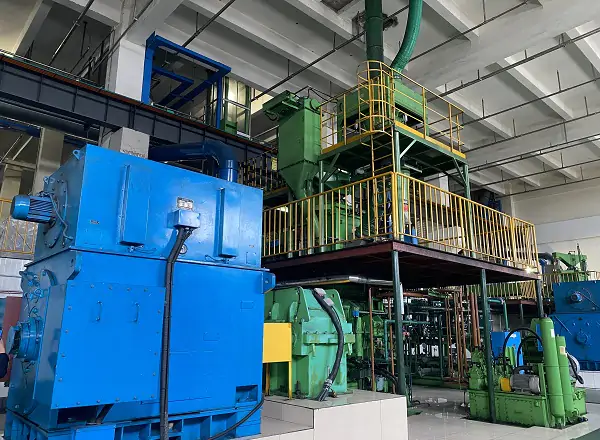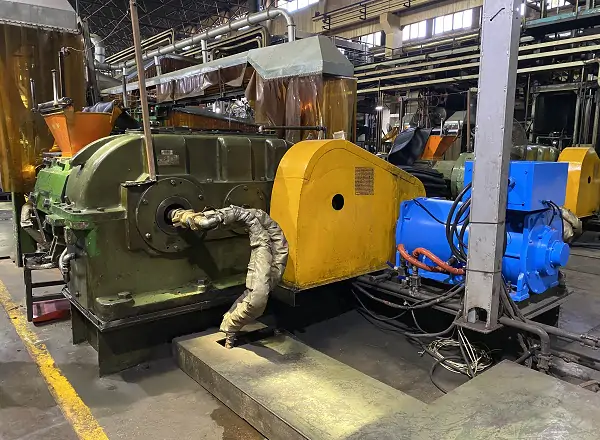Originally, The extruder came from England in the 18th century. In the 20th century, large-scale power systems began to appear. The electric operation of the extruder rapidly replaced the old manual extrusion machine. At this point, electric power is preferred for the selection of power by the extruder, and the motor becomes the main source of power and the main component of the current most important part of the machine for extrusion.
History of Extruders
Origin in England in the 18th Century
The extruder concept was born in England during the 18th century. Initially, the extruders were simple devices used for simple tasks, such as shaping clay or food. These early machines were manually operated, with much human labor required to apply pressure and force materials through a die to create desired shapes. This labor-intensive process was the standard until significant technological developments began to reshape the industry.
Evolution with Large-Scale Power Systems in the 20th Century
The large-scale power systems of the 20th century revolutionized the technology of extruders. As more electrical power became available and accessible, it laid the bedrock upon which the revolution in the operation of extruders was based. Electric power systems integrated into extruders started to signify one of the major conceptual shifts from manual labor to mechanized processes. Electric motors, developed in this age, were capable of providing power constantly and efficiently; therefore, they massively enhanced the performance and output of the extruders.
The shift from Manual to Electric Operations
The shift from manually operated to electric was like a sea change. It had many advantages: speed, precision, and the capacity to handle most materials electric extruders possessed when compared to manual ones. The switch to this increased output manifold while decreasing human exertion enabled more intricate and heavy manufacturing to take place.
The concept involved placing electric motors at the heart of this new generation of extruders, after which optimization of motor selection took center stage for a range of extrusion applications. The motor became important in the overall efficiency and performance of extruder machines, including their maintenance schedules. The evolution thus set a basis for rapid growth in the motor technological advances and its application on the extruders, ultimately laying down systems highly used and efficient in modern manufacturing today.

Importance of Motor Selection in Extruders
Role of Motors in Extruders
Motors are a very crucial aspect of the functioning of an extruder. Motors provide the driving power to the whole process of extrusion. The type of motor selected directly influences the efficiency, performance, and reliability of the extruder. The main role of the motor includes the following aspects:
They are mechanical power transmission force machines used for driving the extrusion screw which at high pressure forces raw material through a die to assume a shape. The required output from the motor must meet the needs arising in any particular process if the operation is to be uniformly smooth.
The performance characteristics of the extruder are mostly dependent on the type and quality of the motor since speed, torque, and energy efficiency depend on this element. An appropriately chosen motor will raise the ability of the extruder to work with a wide range of processed materials and achieve production goals efficiently. Besides, ease of maintenance and durable life of the motor affect total operational costs and downtime; thus, motor selection becomes critical for long-term reliability and efficiency.
Rapid Development in the Plastic Industry
The rapid growth and technological development in the plastic industry put ever-increasing demands on high-performance extrusion equipment. As this industry continues changing, so too do those demands that motor technologies address. In such a changing environment, the right motor types must be properly chosen in light of the changing demands of their applications in extrusion processes.
Necessity of Choosing Appropriate Motor Types
With the development of newer materials and more sophisticated extrusion requirements, the selection of motors becomes crucial. Motors should be able to give accurate speed and torque control to handle various plastic formulations and extrusion profiles. Besides this, energy efficiency has emerged as one of the key factors with manufacturers striving to decrease operational costs and reduce their ecological footprint.
Selection of the proper motor involves consideration of several factors: those related to the particular extrusion process, the nature and type of materials in the process, and the characteristics of the final product. Advances in motor technology offer new opportunities for improving extruder performance and efficiency, including AC permanent magnet synchronous motors and multi-pole motors. Such motors are capable of providing high-speed regulation, high torque, and low power consumption, thus meeting modern-day demands in plastic manufacture.
Evolution of Motor Types in Extruders
In a way, extruder motor technologies have been in a state of evolution with demands for improved performance, efficiency, and ability to adapt to the changing industrial requirements. Over the years, the preference for types of motors has shifted as new technologies emerged, each with its advantages and challenges.
Preference for DC Motors
The electric drive applied to extruders initially favored DC motors because they had excellent speed regulation performance. It was easy to vary the speed of DC motors, and hence they proved to be highly suitable for the precise control that is usually required in the extrusion process. This helped manufacturers modify the extrusion speed as required for various material-specific and product-specification requirements.
Speed Regulation Performance
DC motors are excellent at speed control, which is a prime prerequisite for ensuring that extrusion quality is maintained. Accurate maintenance of motor speed enables the extruder to fabricate products within specified tolerances, which becomes important when the applications call for tight tolerances.
Despite such advantages, DC motors had some considerable disadvantages for which they were largely being replaced by other types of motors over time.
Disadvantages of DC Motors
While DC motors had very good speed regulation, they also had several major disadvantages that made them unsuitable for long-term use in modern extruder applications.
Due to these disadvantages, the industry started searching for other alternative motor technologies that would provide all the merits of DC motors without their disadvantages.
Shift to AC Motors
The search for better solutions led to the adoption of AC motors that are more compatible with standard power grids and, at the same time, promise improved reliability and lower maintenance requirements. Among the types of AC motors, a lot of interest has been centered around AC permanent magnet synchronous motors.
Advantages of AC Permanent Magnet Synchronous Motors
In perspective, these motors effectively marry the advantages of precise speed control with the robustness and lower maintenance needs of AC motors. Most energy-efficient with high torque, they find applications for a wide range of requirements in the extrusion process. Since more compact designs are prevalent, they can be accommodated within the modern extruder system and, hence, this is becoming a favorite choice with the manufacturer for better performances and reducing operational costs.
The development of extruder motor types reflects the eternal quest of industry for performance, efficiency, and reliability. Thus, AC motors applied with better technologies in place had already replaced the DC motors used earlier to provide very good speed regulation that was highly incompatible with an AC grid, besides needing high maintenance. Among others, AC permanent magnet synchronous motors have emerged to provide the precision and efficiency required in modern extrusion processes. That is how the evolution has shown that nothing is static, and one has continuously to innovate and adapt to the current needs of the plastic manufacturing industry.
Introduction of Multi-Pole Motors
Extruder technology with a multi-pole motor means another stride toward efficiency, effectiveness, and operational simplicity. These are specially developed given the growing high demand for modern extrusion processes; therefore, because of the many benefits that crop up, they can be quite attractive options. Hence, multi-pole motors have characteristics such as:
Characteristics of Multi-Pole Motors
Some of the key features that distinguish multi-pole motors from all other conventional motor designs include several important features that are responsible for their supremacy in performance and adaptability in extrusion applications.

Fundamentally, multi-pole motors are designed for low-speed operations; normally less than 100 revolutions per minute. These low speeds are very ideal for applications that require exact control of the process of extrusion to deliver consistent quality products with fewer possibilities of defects.
The major advantage of multi-pole motors is that they can be coupled directly to the extrusion screw and flange. Because no intermediary mechanical linkages are required, the system becomes much more streamlined and less prone to inefficiency. By removing some of the mechanical linkages, multi-pole motors boost the overall reliability and performance of the extruder.
Benefits of Multi-Pole Motors
These characteristics of multi-pole motors translate into several tangible benefits that considerably extend the functionality and efficiency of the extrusion systems.
Classic or typical applications that make use of gearbox and belt wheel couplings, therefore, transmit power from a motor to an extrusion screw. The elimination of these components in an operation setup means reduced complexity by the multi-pole motor. Reduced numbers of pieces will reduce possible points of failure, increasing reliability and reducing downtime for the extruder.
The multi-pole motors allow a more compact and lightweight extruder design with fewer mechanical components. This simplification makes the machine more attractive at the same time easier and faster to maintain. The motor and other important components are quickly accessible for servicing by the operator, reducing downtime and maintenance costs.
Multi-pole motors have been designed to run efficiently at low speeds with much higher energy savings than conventional motor systems. By better-optimizing power consumption, the motors can help manufacturers reduce operational costs and further improve sustainability for their overall extrusion processes.
Some features are distinguished by the no-pole speed regulation capability of multi-pole motors. This facilitates continuous and precise variation of motor speed to meet the different extrusion processes. Regardless of whether high precision or high throughput is required from specific applications, multi-pole motors can be fine-tuned.
The multi-pole motor represents a new step in developing extruder technology. It inherits from low-speed control and is directly connected with such advantages that further enhance the efficiency, reliability, and simplification of the extrusion system. Without complex mechanical elements and with precise speed regulation, manufacturers can achieve higher performance and energy savings through the use of multi-pole motors suitable for current extrusion applications.